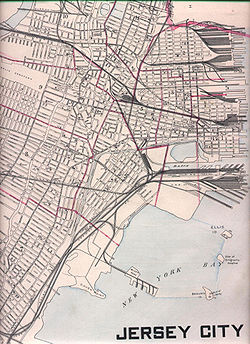User:Djflem/NJvsNY
Jurisdictional disputes

There have been a number of disputes of the jurisdictional status of Liberty Island.
An unusual clause in 1664 colonial land grant outlined the territory the propriators of New Jersey would receive as "westward of Long Island, and Manhitas Island and bounded on the east part by the main sea, and part by Hudson's river", [1] rather than at the river's midpoint, as was common in other colonial charters.
When the Province of New Jersey was separated from the Province of New York in 1674 it was argued that Staten Island belonged to the former. Then governor Edmund Andros directed that all islands in the bay that could be circumnavigated within 24 hours were part of New York. Soon thereafter, Captain Christopher Billopp sailed around it witihin the allotted time.[2]
The border came to be understood as being along the shore of the of Hudson River, the Upper New York Bay, the Kill van Kull, and Arthur Kill.
This was not contested until 1830. New Jersey brought suit, [3][4] but the matter was resolved with a compact between the states ratified by US Congress in 1834 which set the boundary line between them as the middle of the Hudson River and New York Harbor.[5][6] This was later confirmed by the US Supreme Court in a 1908 case which also expounded on the compact.[7]
In 1987, US Representative Frank J. Guarini and Gerald McCann, then Mayor of Jersey City, sued New York City, contending that New Jersey should have dominion over Liberty Island because is on the New Jersey side of the state line.[8] By default—since the court chose not to hear the case—the existing legal status was unchanged. Portions of the island that are above water are part of New York, while riparian rights to all of the submerged land surrounding the statue belong to New Jersey.
A 1997 United States Supreme Court decision involved such riparian rights around nearby Ellis Island. Being mostly constructed of artificial infill, New Jersey argued and the court agreed that the 1834 compact covered only the natural parts of the island, and not the portions added by infill. Thus it was agreed that the parts of the island made of filled land belonged to New Jersey while the original natural part belonged to New York. This proved impractical to administer and New Jersey and New York subsequently agreed to share jurisdiction of the entire island. [9][10]This special situation only applies to Ellis Island and part of Shooter's Island. The court chose not to comment on the precedent in the unlikely event that Liberty Island would be expanded.
NEW JERSEY v. NEW YORK 523 U.S. 767 (United States Supreme Court 1998), NEW JERSEY v. NEW YORK 523 U.S. 767 (1998) Text.
Historical circumstances have led to the rare situation of an exclave of one state, New York being located completedly within another, New Jersey. The built portion of Liberty Island (as well as 3 acres of nearby Ellis Island) are under the jurisdiction and are part of New York City. They are bounded completely by the municpal borders of Jersey City, New Jersey, which retains riparian rights to all its portions of the Hudson River and the Upper New York Bay. Liberty Island has been the property of the United States government since 1808, and until 1944 served as a military installation called Fort Wood. It has been operated by the National Park Service since 1937. The dominion of the island has been the subject of various land grants, government directives, interstate compacts, and Supreme court decisions. [11] [12] [13][14]
- ^ The Duke of York's Release to John Lord Berkeley, and Sir George Carteret, 24th of June, 1664
- ^ Moss, Mitchell (Summer 1988), "New York vs New Jersey: A New Perpsective", Portfolio (PANYNJ), 1 (2)
{{citation}}: CS1 maint: date and year (link) - ^ NEW JERSEY V. NEW YORK, 28 U. S. 461 (1830)
- ^ Greenhouse, Linda (May 27, 1998), "THE ELLIS ISLAND VERDICT: THE RULING; High Court Gives New Jersey Most of Ellis Island", New York Times
- ^ Rieff, Henry, "Intrepretations of New York-New Jersey Agreements 1834 and 1921" (PDF), Newark Law Review, 1 (2)
- ^ "Statue of Liberty National Monument - Frequently Asked Questions". NPS.gov. National Park Service. Retrieved February 1, 2010.
- ^ Central R. Co. of New Jersey v. Jersey City, 209 U.S. 473 (1908)
- ^ "New Jerseyans' Claim To Liberty Island Rejected". Associated Press. New York Times. October 6, 1987. Retrieved 2010-01-27.
{{cite news}}: Cite has empty unknown parameter:|coauthors=(help) - ^ NEW JERSEY v. NEW YORK 523 U.S. 767 page 779
- ^ Greenhouse, Linda (May 27, 1998), "THE ELLIS ISLAND VERDICT: THE RULING; High Court Gives New Jersey Most of Ellis Island", New York Times
- ^ The Duke of York's Release to John Lord Berkeley, and Sir George Carteret, 24th of June, 1664
- ^ Moss, Mitchell (Summer 1988), "New York vs New Jersey: A New Perpsective", Portfolio (PANYNJ), 1 (2)
{{citation}}: CS1 maint: date and year (link) - ^ NEW JERSEY V. NEW YORK, 28 U. S. 461 (1830)
- ^ Greenhouse, Linda (May 27, 1998), "THE ELLIS ISLAND VERDICT: THE RULING; High Court Gives New Jersey Most of Ellis Island", New York Times
- ^ Rieff, Henry, "Intrepretations of New York-New Jersey Agreements 1834 and 1921" (PDF), Newark Law Review, 1 (2)
- ^ "Statue of Liberty National Monument - Frequently Asked Questions". NPS.gov. National Park Service. Retrieved February 1, 2010.
- ^ Central R. Co. of New Jersey v. Jersey City, 209 U.S. 473 (1908)
